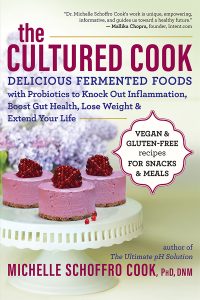 The importance of a healthy microbiome has been talked about a lot in health news lately. It’s crucial to our immune system, our brain health, our digestion, and even our mood. The best way to build a healthy microbiome is with fermented foods. Buying them can be pricy, and the beneficial bacteria that they contain can be killed off in processing. Fermenting foods at home can seem daunting, but fortunately Michelle Schoffro Cook’s new book The Cultured Cook: Delicious Fermented Foods with Probiotics to Knock Out Inflammation, Boost Gut Health, Lose Weight & Extend Your Life is here to make things easy.
The importance of a healthy microbiome has been talked about a lot in health news lately. It’s crucial to our immune system, our brain health, our digestion, and even our mood. The best way to build a healthy microbiome is with fermented foods. Buying them can be pricy, and the beneficial bacteria that they contain can be killed off in processing. Fermenting foods at home can seem daunting, but fortunately Michelle Schoffro Cook’s new book The Cultured Cook: Delicious Fermented Foods with Probiotics to Knock Out Inflammation, Boost Gut Health, Lose Weight & Extend Your Life is here to make things easy.
The Cultured Cook is an amazing resource for making your own fermented foods. The book delves into the importance of including fermented foods in your diet, along with a list of health benefits, an explanation of what exactly a microbiome is (hint: it’s the system of microbes in the gut), and tips on boosting the beneficial bacteria in your gut.
Fermenting foods at home as always seemed a little scary to me. Will the food go bad? Will I have exploding jars in my kitchen? Do I have to spend a ton of money on equipment? The Cultured Cook has put my mind at ease, because Michelle Schoffro Cook explains just how easy and inexpensive it actually is. In most of the recipes, you just need a simple starter, which can be a probiotic capsule or easy-to-make rejuvelac, a glass bowl, and a few ingredients. It really can’t get any easier than that!
Within the pages of The Cultured Cook, you’ll find recipes for vegan yogurts, non-dairy cheeses, vinegars, komucha, pickels, sauerkraut, and more. Michelle has also included recipes for using these delicious cultured creations, such as dips, cheesecakes, and ice creams. She includes tips and helpful information throughout the book.
There are so many recipes that look so easy throughout the book, and I really have no excuse to continue to buy foods like yogurt and komucha. The big problem I had was deciding what to start with! Should I make sauerkraut? Maybe some kimchi? In the end, I settled on Aged Miso Cheese. It’s super simple and I already had all of the ingredients on hand. I have my cashews fermenting as I type this.
I have a few other books on fermenting foods at home, but none of them are plant-based, so I’m happy to have this vegan cookbook as part of my library. It’s an absolute must-have for anyone who wants to make cultured foods at home!
- 2 cups raw, unsalted cashews
- 1 cup filtered water
- 1 tablespoon dark miso
- 3 teaspoons unrefined sea salt, divided
- ½ cup coconut oil
- In a glass or ceramic bowl with a lid, combine the cashews, water, and miso, and stir until they are combined. Cover and let sit for twenty-four hours.
- Pour the cultured cashews into a blender. Add 1 teaspoon of the salt as well as the oil, and blend until smooth. You may need to push the ingredients down with a spatula a few times to ensure a creamy, smooth consistency.
- Pour the cheese mixture into a cheesecloth-lined bowl that is the shape you’d like the finished cheese to be. Refrigerate for four to six hours, or until it is firm. Remove the cheese from the bowl, and peel away the cheesecloth.
- Gently rub the remaining 2 teaspoons of salt over the full surface of the cheese, including the bottom. Carefully place it on a wire rack in a cool, dark, and undisturbed place, and allow the cheese to air-dry for seven to twenty-eight days, or longer if desired. After you have aged the cheese, refrigerate and serve, or store in a covered container in the refrigerator for up to one month.


I do not like leaving food out in the open like that. Any advice? Is in the cupboard ok?